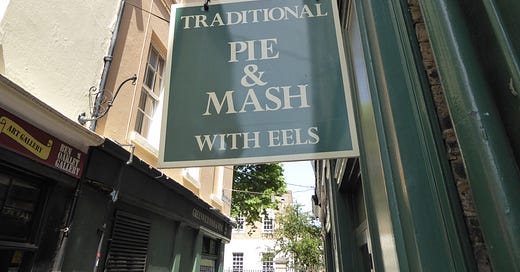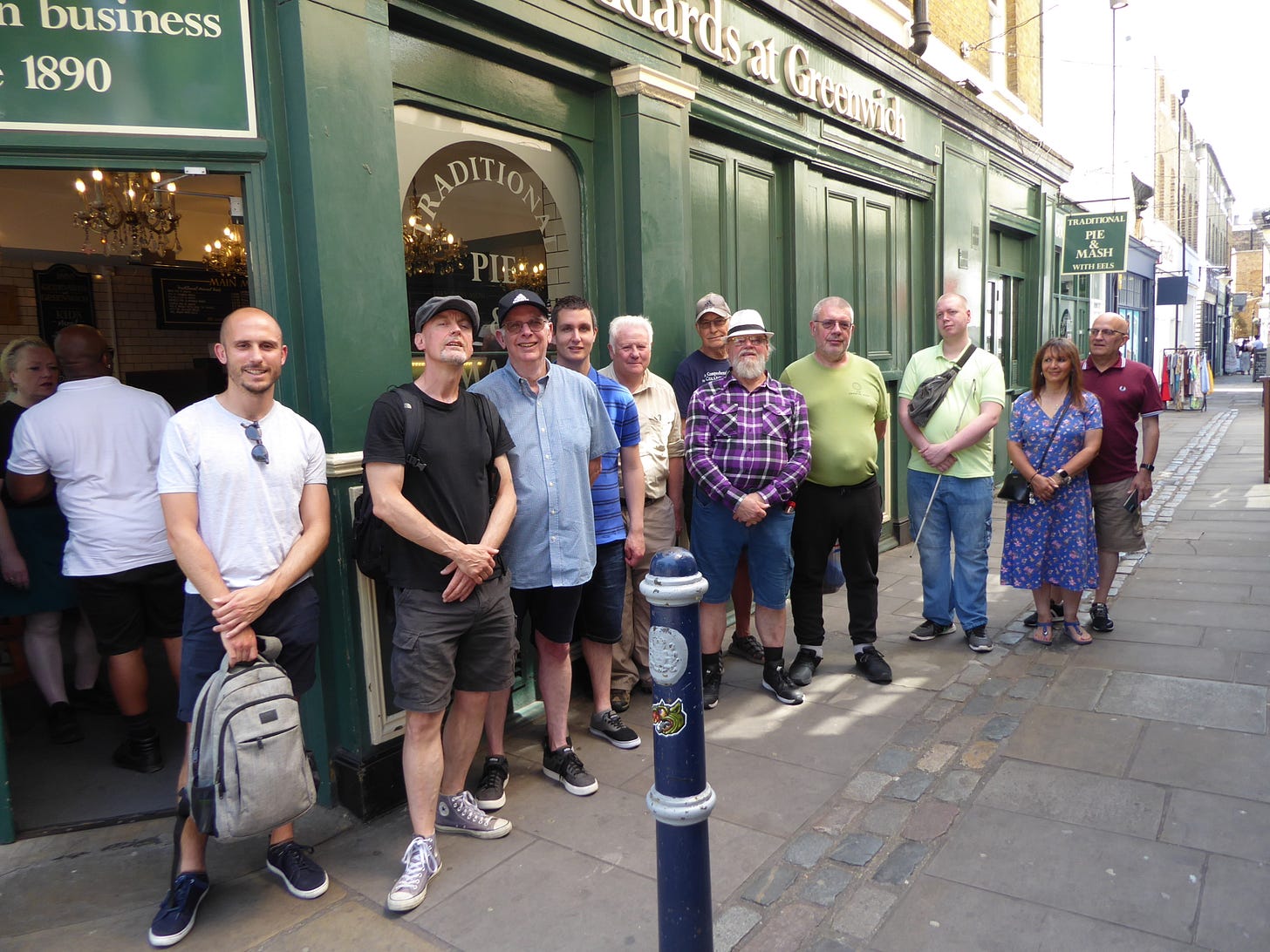It’s a stifling Friday afternoon in June and the last thing I feel like eating is minced beef pie served with mounds of mash and drenched in scalding parsley sauce.
I’ve got nothing against the classic London staple - it’s the city’s original fast-food, dating back to the 19th century when it was popular among the working classes in the East End. I just think it would be more enticing on a wretched winter’s day than in the 30-odd degree heat.
However, when I stumbled across the Pie and Mash Club online - with its history spanning nearly 30 years, an all-time leaderboard of competitors, and droll write-ups of its lunch meetings - I was determined to participate in the last “fixture” of the 2021/22 season.
Following an email conversation with the club’s founder Nick Evans, I find myself awkwardly posing for a group photo with about a dozen strangers outside Goddards in Greenwich, just after 1pm. Sweaty handshakes and warm welcomes exchanged, we head inside to eat.
As a newcomer not just to the club but the history, culture and customs of pie and mash, I seek advice from Evans, a man whom the records show to have eaten more than 633 pies and about 400 portions of eels - both jellied and stewed - since founding the club in 1994.
First of all, we’re in a shop, not a restaurant. When I say I’m considering ordering two pies and servings of mash, Evans tells me to ask for a “double, double”. It seems like a steal at just £7.20. Gravy is on the menu but it’s not traditional, and opting for it will not score me any points (more on that later) but likely result in mockery from the club’s veterans. And, he warns with a grin, I can’t use a knife while eating - a fork and spoon are the tools of choice.
Evans, a graphic designer from Dorset, says the idea for the club came about when he was working for a publisher in the early 90s and ended up at a pie and mash shop in Waterloo one lunchtime.
“I didn’t grow up with pie and mash so when I first had it, I thought: ‘Eurgh, what’s this about, I’m not sure about it’” the 56-year-old says as we order. “But it was something nice to do that didn’t revolve around drinking, it was a good lunchtime activity.”
From there, the club attracted interest and members through word of mouth until it went online in 2003. The leaderboard shows that about 250 people have attended a meet-up, although Evans says there are currently 100-odd members on its mailing list and that a dozen or so of them turn up on a good day.
“Some shops are tiny and can barely take us. When you step into the smaller, family-run places, you feel like you’re stepping into someone’s house,” he says, recalling a visit to the now-closed Peter’s in Shadwell where everybody ordered eels and cleaned the shop out.
“This local elderly woman turned up as she did every Friday for her eels and was gutted!”
Thankfully, there is ample room for the club in Goddards - and more than enough food.
As we carry our plates from the counter and take our seats - the group an eclectic mix of retirees from the East End, middle-aged West Ham fans living in Essex and 30-somethings based across the city- I’m struck by the instant and easy sense of camaraderie.
Conversation topics range from the perfect pie crust and correct consistency of liquor to the gentrification of east London and the ties between football clubs and pie and mash shops.
For some people, the club is an occasional treat on a Friday afternoon: a leisurely lunch, a chit-chat and a pint afterwards at a nearby pub if time allows. For the old-timers and the regulars, it’s an important tradition that is clearly cherished yet also taken seriously.
It feels like stepping back in time to an age before social media and smartphones (you receive a five point penalty if your mobile rings), where all that matters is the food in front of you, the people around you, and lively conversations.
“This gets me out of the house, it’s a rare social outing,” says Terry Moore, a 33-year-old from Romford who is visually impaired, as I struggle to remove my pie’s lid with a spoon.
Today marks only the second time Moore has got on a train since the pandemic started more than two years ago. He is mild mannered and softly spoken but becomes increasingly animated as he tells me how he helped to build the club’s website after joining in 2015.
Sitting next to him, Mike Goldwater - the club’s de facto photographer - gets surprisingly philosophical while recounting the last decade or so as one of the ever-presents.
“It is not just about the pie, but the people, the competitive aspect and the surprises along the way - it’s a bit of a journey really,” the Edgware-based 32-year-old says, before explaining that the club occasionally visits places further afield - from Skipton to Herne Bay.
While I’m struggling to finish the dessert I was cajoled into ordering - an apple crumble with custard - the scoresheet is passed around. You score four points for each pie and portion of eels, three for mash, two for dessert, and one for liquor. If you don’t finish any items, you lose the corresponding amount of points. My score of 17 is deemed solid if not spectacular.
With this being the twelfth and final fixture of the season, a champion must be crowned.
Fittingly, it’s Evans who takes the title - in this case a ceramic pie and mash themed platter called the Realistic Clay Pies trophy. It’s his eighth championship overall, but first win in 11 years. There are also prizes for second and third - most notably a bib proclaiming ‘I dribbled for England in the pie and mash league’ - and a consolation wooden spoon for last place.
Not a club to stand on ceremony, we swiftly shuffle on to the closest pub for a post-pie pint, debrief and lively debate about the future of pie and mash shops.
Central London has lost several establishments in recent years, but Evans says that more are opening in Kent and Essex - following people out of the city and to the home counties. While he believes the sense of community and value for money offered by pie and mash shops will sustain their existence, he feels that passing the tradition down from generation to generation is key.
“This is a priceless thing but, really, it’s all about families and parents,” he says while sipping his ale. “If they don’t take their kids and pass it on - then it’ll all be over in the future.”
Later that evening - whilst still uncomfortably full - I call the owner of my local shop, Neil Vening of G. Kelly in Bow, to ask about his business, and whether the days of pie and mash might be numbered.
Though the 83-year-old shop re-opened in 2019 after a two-year refurbishment only to face the pandemic and cost-of-living crisis, the 31-year-old is resolute and optimistic.
“It’s not a dying trade just because a few shops shut down in central London, it’s booming elsewhere,” says Vening, who has been involved in the family business since he was a teenager.
“In fact, I think there’s renewed interest in pie and mash because it is one of the few representations of real British food that is actually food of the people … there’s an understanding that it’s a part of our culture.”
/////
Pictures: Mike Goldwater




